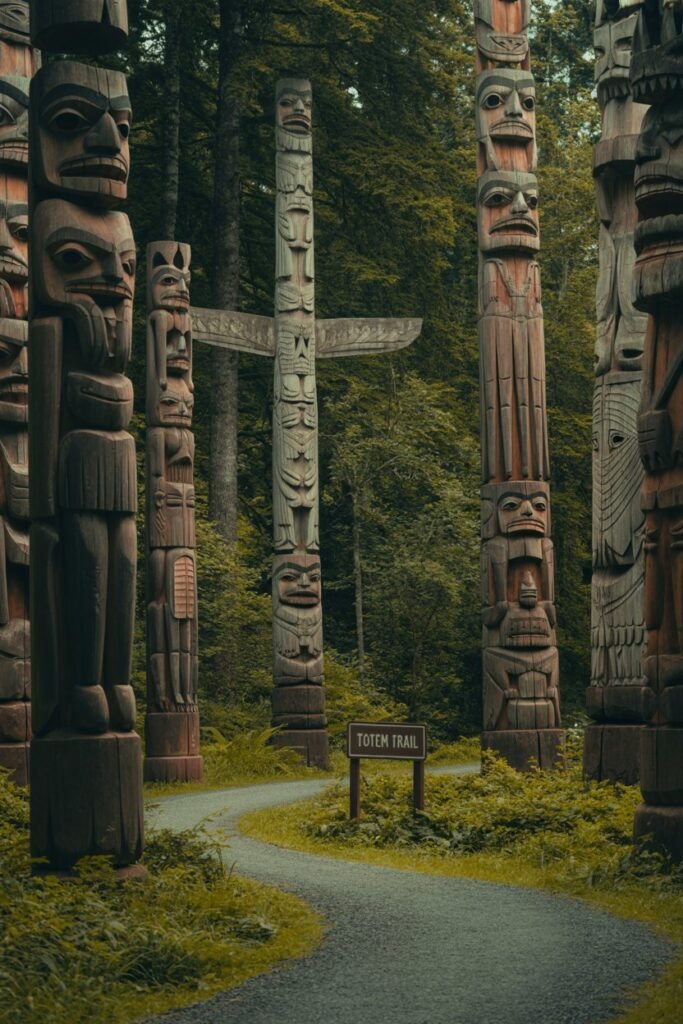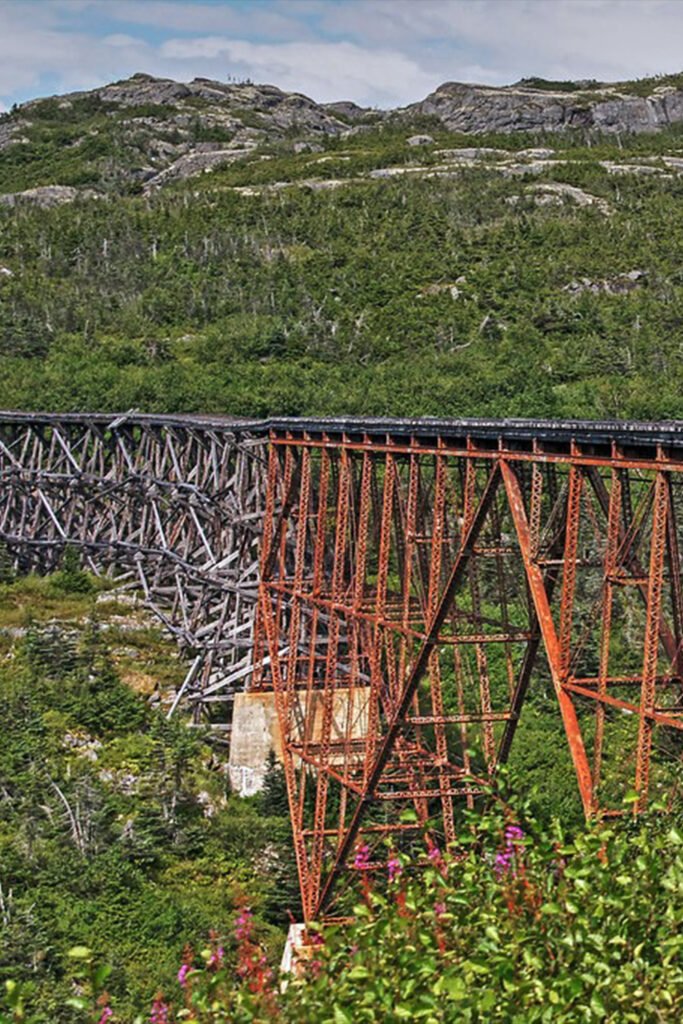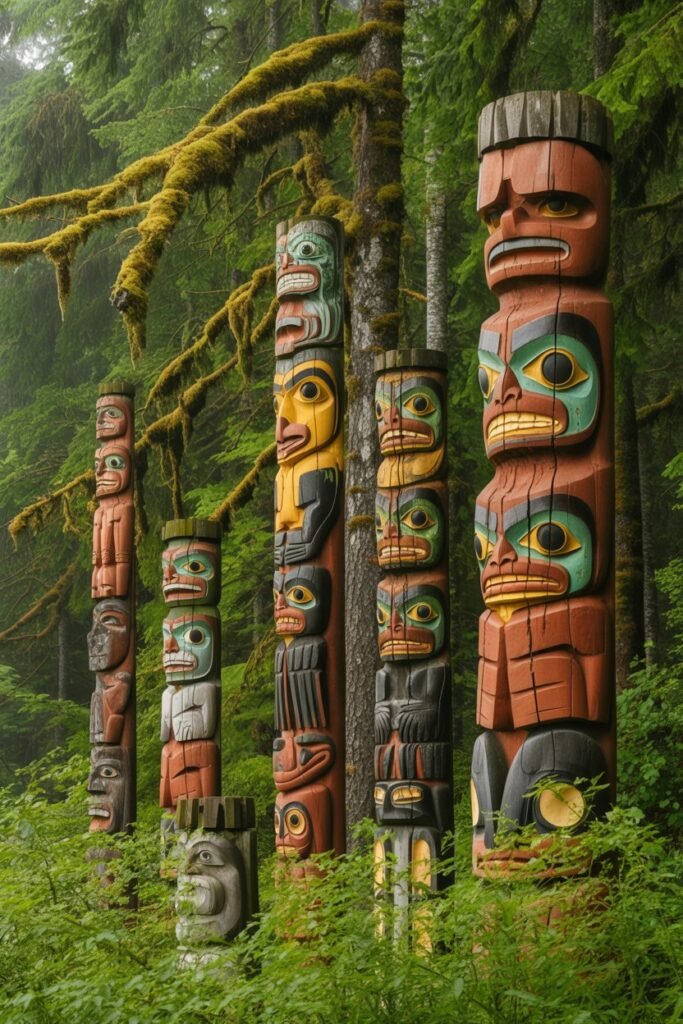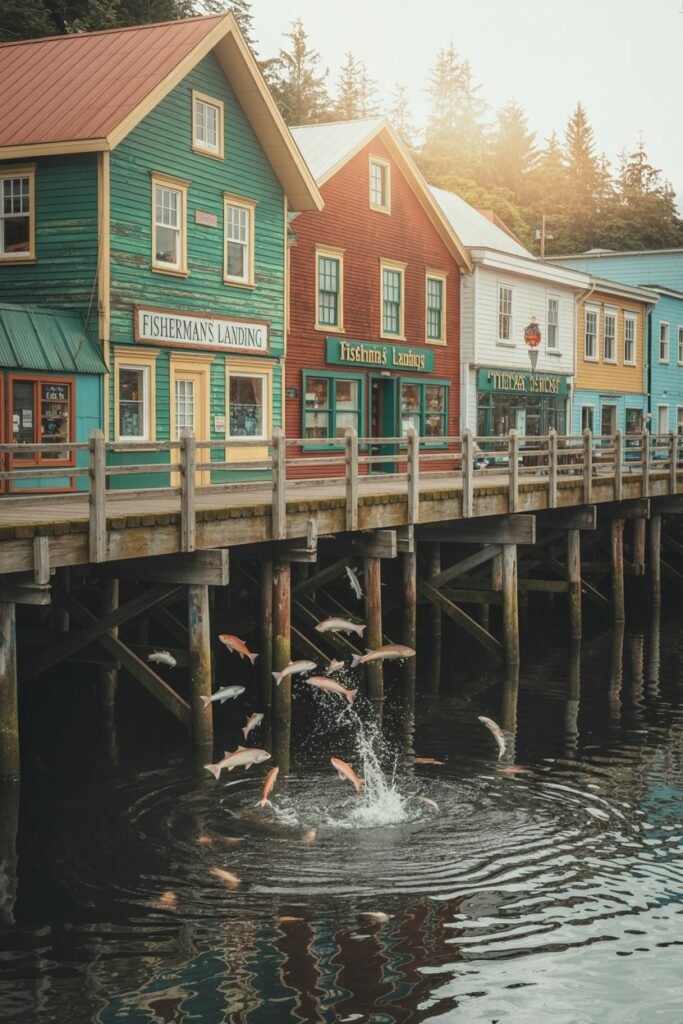Estimated reading time: 13 minutes
Key Takeaways
- Sitka blends Russian and Indigenous Tlingit cultures, offering unique historical sites like Saint Michael’s Cathedral and the Russian Bishop’s House
- The Skagway White Pass Railroad provides a scenic journey through the Coast Mountains with spectacular views of gorges, waterfalls, and peaks
- Ketchikan is known as the “totem pole capital of the world” with attractions like the Totem Heritage Center showcasing Indigenous art and culture
- Creek Street in Ketchikan has transformed from a gold rush era red-light district to a charming historic boardwalk lined with shops and galleries
- Alaska cruise ports offer a perfect blend of cultural immersion, historical exploration, and natural beauty
Table of Contents
- Introduction
- Exploring Sitka: A Blend of Russian and Tlingit Heritage
- Skagway: Gold Rush History and Scenic Railroad Adventures
- Exploring Ketchikan, Alaska
- Frequently Asked Questions about Alaska Cruise Ports
- Conclusion
Introduction
Alaska stands as a premier cruise destination celebrated for its dramatic landscapes, abundant wildlife, and unique blend of cultures. Beyond breathtaking fjords and towering glaciers, visitors encounter towns rich with history and local flavor. If you’re planning an Alaska vacation, you’ll want to know about the three essential port stops that offer exceptional opportunities to dive into Alaska’s diverse cultural roots, explore storied pasts, and embark on true adventures.
This blog spotlights three main port stops for cruise travelers: Sitka, Skagway, and Ketchikan. Each destination provides unique perspectives on Alaska’s heritage and natural beauty. From discovering the best things to do in Sitka, Alaska, to experiencing the thrill of the famous Skagway White Pass Railroad to exploring cultural treasures in Ketchikan, these ports give cruise travelers everything they need for unforgettable shore excursions.
Want to watch in UHD 4K Resolution? Click here to watch the full Wonders of Alaska Travel Documentary on YouTube.
Exploring Sitka: A Blend of Russian and Tlingit Heritage
Overview of Sitka’s Heritage
Sitka distinguishes itself from other Alaskan ports with its fascinating blend of Russian and Indigenous Tlingit culture. Originally a Tlingit settlement, Sitka became the capital of Russian America in the early 19th century after a pivotal battle in 1804. This significant historical event is now commemorated in Sitka National Historical Park, where visitors can walk among towering totem poles and learn about this decisive moment in Alaskan history.
The cultural fusion that occurred during the Russian period created a unique heritage that remains visible throughout the town today. Unlike other parts of Alaska that experienced primarily British or American influence, Sitka’s architectural landscape and historical narratives reflect its distinct Russian colonial past.

Key Historical Landmarks in Sitka’s Russian-American Legacy
The most prominent landmark displaying Sitka’s Russian American history is Saint Michael’s Cathedral, with its distinctive onion dome that has become an iconic symbol of the town. The current structure is a meticulous reconstruction after a fire destroyed the original 1848 building, but it retains authentic icons and religious artifacts that survived the blaze [SOURCE].
Another significant historical site is the Russian Bishop’s House, built in 1842. This National Historic Landmark stands as one of the few surviving colonial Russian structures in North America. It served as both a residence and a religious center for Orthodox bishops who oversaw Russian America’s spiritual affairs [SOURCE].
History buffs shouldn’t miss the Russian-American Building No. 29, constructed in 1852. This rare log building survives from the Russian American Company era and provides valuable insights into colonial life and architectural practices from this period [SOURCE].
Cultural & Natural Attractions
Beyond its historical treasures, Sitka offers natural beauty that rivals any port in Alaska. The town’s scenic coastline provides spectacular ocean vistas and abundant opportunities to spot marine wildlife. Visitors can join guided kayaking tours or wildlife cruises to see sea otters, bald eagles, and even whales in their natural habitat.
Cultural attractions include Tlingit dance performances and craft demonstrations that showcase the living traditions of Alaska’s Indigenous peoples. The combination of Russian architecture and Tlingit artistry creates a visually striking backdrop for these cultural experiences.
For nature lovers, easy access to forest trails allows for quick escapes into the lush Tongass National Forest, where visitors can experience Alaska’s famous temperate rainforest ecosystem without venturing far from port.
Why Cruise Passengers Love Sitka
For cruise passengers with limited time in port, Sitka offers an efficient way to experience both human history and natural splendor in one compact, walkable area. The town’s relatively small footprint means visitors can trace Russian and Tlingit legacies in the morning and still have time for wildlife viewing or forest hikes in the afternoon.
The rich historical narratives and stunning coastal scenery make Sitka a favorite among travelers looking for deeper connections to Alaska’s past while enjoying its natural beauty [SOURCE].
Skagway: Gold Rush History and Scenic Railroad Adventures
Skagway Overview
Skagway serves as a gateway to both Alaska’s wilderness and its gold rush history. This small town, nestled at the northernmost point of the Inside Passage, attracts adventurers and history enthusiasts alike with its well-preserved frontier character and access to spectacular mountain terrain.
During the late 1890s, Skagway transformed from a quiet coastal settlement to a bustling boomtown when tens of thousands of gold-seekers streamed through on their way to the Klondike goldfields. This dramatic period shaped the town’s identity and left behind infrastructure and stories that continue to define Skagway today.
The Skagway White Pass Railroad Experience
The Skagway White Pass Railroad stands as the premier attraction for visitors to this historic port. This vintage narrow-gauge train climbs steep grades through the Coast Mountains, offering passengers jaw-dropping views of gorges, waterfalls, and snow-capped peaks along the same perilous route that fortune-seekers once trekked with their supplies.
The engineering marvel of this railroad becomes even more impressive when you consider it was built between 1898 and 1900 during the height of the gold rush. The train journey takes visitors through tunnels carved through mountains, across bridges spanning deep canyons, and past historic sites like Dead Horse Gulch, where many pack animals perished during the difficult journey to the goldfields.

Interpretive guides aboard the train share tales from the gold rush era, providing a vivid window into the grueling experiences of 1890s “stampeders” who risked everything for the promise of riches. The contrast between their difficult journey on foot and the comfortable train ride today offers a poignant perspective on how much has changed in just over a century.
Popular Hikes and the Chilkoot Trail
For those seeking more active adventures, Skagway serves as the starting point for several spectacular hiking trails. Most notable among these is the Chilkoot Trail Hike, once known as the “meanest 33 miles in history.” This historic route was the main footpath for gold rushers heading to the Yukon Territory and has now become a world-renowned backpacking route.
While the complete Chilkoot Trail requires multiple days and permits to complete, day hikers can experience portions of this historic path. Even a short hike gives visitors a sense of Alaska’s vast wilderness with mossy forests, tumbling rivers, and poignant gold rush relics scattered along the way.
Other popular hiking options include the Lower Dewey Lake Trail, offering beautiful forest and lake views with moderate effort, and the more challenging Upper Dewey Lake Trail, which rewards hikers with panoramic vistas of the Lynn Canal and surrounding mountains.
Where History and Adventure Blend
What makes Skagway truly special is how seamlessly it blends historical experiences with outdoor adventures. In the morning, visitors might explore the Klondike Gold Rush National Historical Park and walk the wooden boardwalks of the restored historic district. By afternoon, they could be standing on a mountain pass gazing across the same vistas that challenged gold seekers over a century ago.
This unique combination makes Skagway appealing to a wide range of travelers. History buffs can immerse themselves in the well-preserved buildings and museums, while outdoor enthusiasts find endless opportunities for hiking, biking, and wilderness exploration just minutes from the cruise ship dock.
Exploring Ketchikan, Alaska
Cultural Introduction to Ketchikan
Ketchikan stands out among Alaska’s cruise ports for its rich Indigenous culture and vibrant arts scene. Known as the traditional territory of the Tlingit, Haida, and Tsimshian peoples, this colorful port town has earned its reputation as the “totem pole capital of the world” with more standing totem poles than any other location [SOURCE].
Built along steep hillsides and stretching along the waterfront, Ketchikan’s physical layout reflects its adaptation to the challenging coastal environment of Southeast Alaska. Its position as the southernmost major port makes it the “First City” many cruisers experience when sailing north from Vancouver or Seattle.
Cultural Attractions in Ketchikan: Totem Poles and Indigenous Art
Among the top things to do in Ketchikan, Alaska, visiting the various totem pole collections offers profound insights into Native Alaskan cultures. The Totem Heritage Center houses one of the world’s largest collections of original 19th-century totem poles rescued from abandoned villages. These weathered masterpieces tell stories of clan histories, important events, and cultural beliefs through their intricate carvings [SOURCE].
For a more immersive experience, visitors can explore Saxman Native Village, where Tlingit artists continue the tradition of totem pole carving. Watching master carvers transform cedar logs into towering works of art provides a living connection to cultural practices that have been maintained for generations [SOURCE].
Another must-see location is Totem Bight State Historical Park, where beautifully restored and recreated totem poles stand in a picturesque rainforest setting. The colorfully painted poles here help visitors understand how these monuments would have appeared when newly created.

Creek Street Ketchikan History
No visit to Ketchikan is complete without strolling along Creek Street, a historic boardwalk built on pilings over Ketchikan Creek. This charming pedestrian area has a colorful past that reflects the town’s frontier spirit. During the gold rush era, Creek Street functioned as Ketchikan’s red-light district, with numerous brothels operating until 1954 [SOURCE].
Today, the brightly painted historic buildings house art galleries, specialty shops, and restaurants. Dolly’s House Museum preserves the history of the district’s most famous madam, offering a glimpse into this aspect of frontier life. Informative plaques along the boardwalk recount the area’s storied past, from illicit businesses to the “married men’s path” that provided discreet access to the district.
The creek itself adds natural beauty to the historical experience. In summer, visitors can watch salmon fighting their way upstream to spawn, a spectacle that draws both human observers and occasionally, bears looking for an easy meal.
Local Experience and Cultural Insights
Beyond the major attractions, Ketchikan offers numerous opportunities to engage with local culture and daily life. The Southeast Alaska Discovery Center provides an excellent overview of the region’s natural and cultural history through interactive exhibits that explain the connections between the environment, Indigenous cultures, and modern industries like fishing and tourism.
For those interested in the maritime heritage of Alaska, the Great Alaskan Lumberjack Show demonstrates traditional logging skills in an entertaining format, while the Alaska Fish House offers a chance to taste locally caught seafood prepared in traditional ways.
These cultural attractions provide cruise passengers with deep insights into Ketchikan’s vibrant culture and storied past, making it much more than just another port stop.

Frequently Asked Questions about Alaska Cruise Ports
What historical sites should I visit in Sitka, Alaska?
Sitka offers a fascinating blend of Russian and Indigenous Tlingit culture, with top historical sites including Saint Michael’s Cathedral, a symbol of Sitka’s Russian-American heritage, and the Russian Bishop’s House, one of the few surviving colonial buildings from the period. For nature lovers, the Tongass National Forest offers opportunities for kayaking and wildlife viewing, with sea otters, bald eagles, and whales commonly spotted.
What is unique about the Skagway White Pass Railroad?
The Skagway White Pass Railroad provides a scenic journey through the rugged Coast Mountains, offering breathtaking views of waterfalls, gorges, and snow-capped peaks. Built during the Klondike Gold Rush, the railroad follows the same route that gold-seekers once traversed, offering passengers a unique historical perspective alongside stunning natural beauty.
What should I know about hiking the Chilkoot Trail in Skagway?
The Chilkoot Trail is a historic route once used by gold rushers heading to the Yukon. Known for its challenging terrain, the trail offers stunning wilderness views and remnants of the gold rush era. Day hikers can explore sections of the trail, enjoying lush forests, rivers, and historic landmarks without needing to complete the entire hike.
What cultural experiences can I explore in Ketchikan?
Ketchikan is rich in Indigenous culture, particularly through its totem poles and arts scene. Must-visit attractions include the Totem Heritage Center, which houses original 19th-century totem poles, and Saxman Native Village, where visitors can watch master carvers work. A stroll down Creek Street, a historic boardwalk, adds a glimpse into Ketchikan’s colorful gold rush past.
When is the best time to visit Alaska’s cruise ports?
The best time to visit Alaska is during the summer months, from late May to September, offering mild temperatures and long days. While July and August are the peak months with the warmest weather, visiting during the shoulder season in May or September provides fewer crowds and still favorable weather conditions.
Conclusion
Each of Alaska’s iconic cruise ports offers a unique perspective on the state’s rich cultural heritage and natural beauty. From the fascinating Russian and Tlingit blend in Sitka to the thrilling gold rush history and scenic adventures in Skagway, and the Indigenous artistry in Ketchikan, these destinations provide unforgettable experiences for travelers. Combining history, culture, and stunning landscapes, Alaska’s cruise ports deliver an enriching journey through the Last Frontier.
If you’re looking to dive deeper into Alaska’s wonders, consider exploring nearby regions like Juneau or Wrangell for a broader understanding of the state’s rich cultural and natural landscapes. Each port presents an opportunity to experience Alaska beyond the surface, connecting travelers to its diverse history and breathtaking beauty.
For more inspiration on Alaska travel, be sure to visit Pathfinders Travel YouTube Channel to watch travel documentaries in stunning 4K resolution that showcase Alaska and other wonders of the world.









